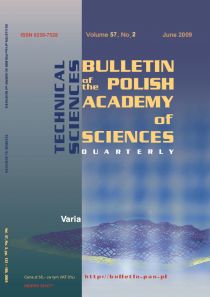POLISH ACADEMY of SCIENCES
TECHNICAL SCIENCES

Power Electronics in Renewable Energy Systems
| BULLETIN
of the
POLISH ACADEMY of SCIENCES TECHNICAL SCIENCES |
 |
|||
|---|---|---|---|---|
| Volume
57, Issue 4, December 2009
Power Electronics in Renewable Energy Systems |
||||
| Issue Index | Authors Index | Scope Index | Web Info | |
|
|
||||
| Aims&Scope, Subscription | Editors | Authors' guide | to read PDF files | mirror: http://fluid.ippt.gov.pl/~bulletin/ |
| pp 297 - 309 |
|---|
|
Integration of distribute denergy sources with electrical power grid |
|---|
| I.WASIAK and Z.HANZELKA |
| The changes that have been taking place recently in the power sector, lead to an increasing share of distributed generation (DG) in the electric power production. Many different energy sources can be distinguished in this area and majority of them incorporate power electronic electrical energy converters interfacing with a power system. Connection of a large number of distributed energy sources (DES) changes the power system work conditions both in positive and negative sense. On the one hand, they emit disturbances to electric power network and on the other hand, they can be effective means of the compensation of such disturbances and also can be used to improve the quality of power delivery. Their additional capabilities are performed by power electronic converters. Development of a modular universal interconnection architecture of these converters with standard functions for power conversion, power conditioning and quality, protection, controls, communications, ancillary services, and metering is the cornerstone of streamlined DG interconnection. Similarly, developing standard certification and testing procedures for the interconnection of DG converters, and then deploying and field testing many of the recently commercialised interconnection devices is a needed step in this process. The main goal of this paper is to present the possibilities of application of the power electronic converters coupling DESs with supply networks to perform ancillary services resulting from supply network characteristics. In the first part the interaction between DESs and networks is described and quantified. Then ancillary services are defined, as the new tasks that designers of converter can/should undertake as well as the standardization gap with respect to the converters that perform ancillary services. For the purposes of this paper the converter is considered to be a black box connected to the power system. The paper concerns DESs connected to distribution networks. |
| Key words: |
|
distributed energy source (DES), power electronic interface, power quality, ancillary services. |
|
|
| Issue Index | Authors Index | Scope Index | Web Info |
|---|---|---|---|
|
|
|||
| Aims&Scope, Subscription | Editors | Authors' guide | to read PDF files |
| Copyright
® Bulletin of the Polish Academy of Sciences: Technical Sciences
January 2010 |
|---|